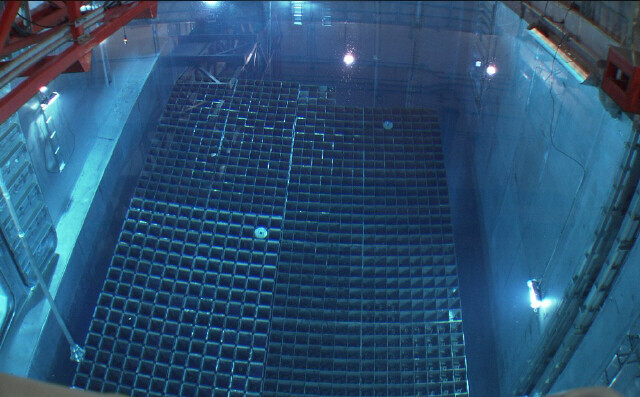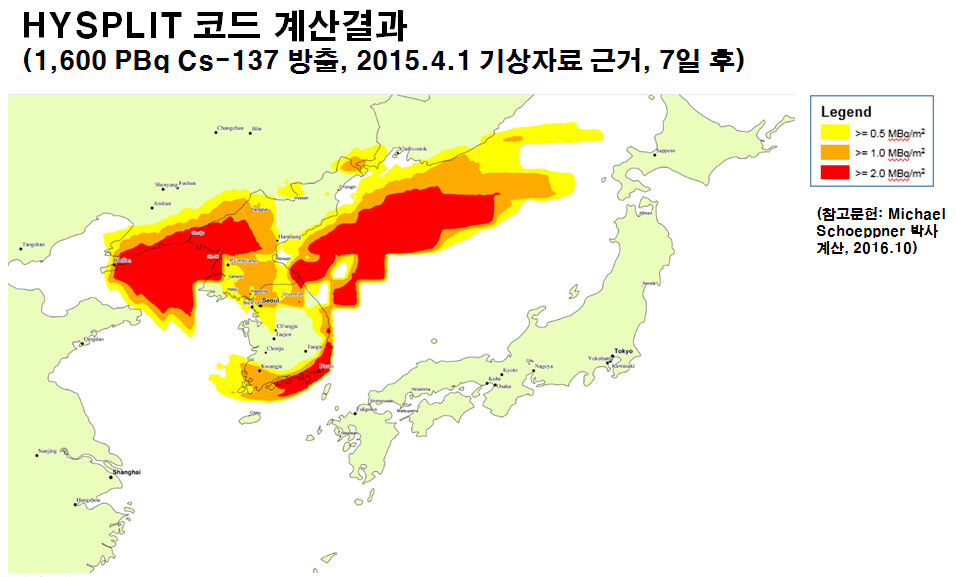hankyoreh
Links to other country sites 다른 나라 사이트 링크
If case of fire at spent nuclear fuel pool, 24 million would need to be evacuated

More than 24 million people would have to be evacuated if a fire occurred at the water pool holding spent nuclear fuel at the Kori No. 3 Nuclear Power Plant, an analysis indicates.
“Analysis with HYSPLIT (Hybrid Single Particle Lagrangian Integrated Trajectory) model, the computer recognized by the US Nuclear Regulatory Commission (NRC) for assessment of atmospheric radiation exposure from a nuclear power plant accident, showed maximum damages covering an area of 54,000 square kilometers or over 50% the national territory, and the evacuation of up 24.3 million people due to leaking of cesium-137 (Cs-137) and other radioactive materials in the event of a fire in the Kori No. 3 reactor spent nuclear fuel water pool,” said senior researcher Kang Jung-min of the US Natural Resources Defense Council in an Oct. 31 debate at the National Assembly on the topic “How dangerous is spent nuclear fuel?”
HYPSLIT code was also the analytical program applied by the US at the time of the 2011 Fukushima Nuclear Power Plant disaster in Japan.
Averages from the analysis, which involved the inputting of meteorological conditions for the first weeks of the months January to December 2015, showed large-scale damages in other countries besides South Korea. In addition to the 5.4 million people who would have to be evacuated in South Korea, another 1.1 million would require evacuation in North Korea, 7.9 million in Japan, and 700,000 in China.
“The method of storing spent nuclear fuel in dense water pools presents a serious risk of accident from the loss of cooling functions, not just from an earthquake, tsunami or other natural disaster but also potentially from a terrorist or missile attack,” Kang said.

“To reduce the damage risk, we need to move [spent fuel] into dry storage facilities five to six years after it comes out of the reactor, and to store in a regular rather than dense way,” he added.
Princeton University professor Frank von Hippel noted the same day that “the US Nuclear Regulatory Commission reported benefits equivalent to just 10% of costs in the case of dry storage, but it also reduced the costs by limiting the danger radius to 80 km and using 1995 figure to calculate life values for cancer deaths.”
“It costs far less to move spent fuel into dry containers than it does to reprocess it,” von Hippel added.
In 2003, the US Congress asked the National Academy of Sciences (NAS) to review a plan for keeping spent nuclear fuel in water pool storage for five years before transferring it to dry containers and storing it on open racks. A report was published in 2006, but the NRC did not take action. Its benefit calculations were released only recently after the Fukushima disaster.
“Reprocessing of spent nuclear fuel is something only about one-fifth of countries operating nuclear power plants are paying any attention to, as most places like the UK and France are either halting operation or considering it,” said von Hippel.
“Declining international prices for low-enriched uranium, the fuel for light-water reactors, mean there is no economic value,” he explained.
By Lee Keun-young, senior staff writer
Please direct questions or comments to [english@hani.co.kr]

Editorial・opinion
![[Column] Has Korea, too, crossed the Rubicon on China? [Column] Has Korea, too, crossed the Rubicon on China?](https://flexible.img.hani.co.kr/flexible/normal/500/300/imgdb/original/2024/0419/9317135153409185.jpg) [Column] Has Korea, too, crossed the Rubicon on China?
[Column] Has Korea, too, crossed the Rubicon on China?![[Correspondent’s column] In Japan’s alliance with US, echoes of its past alliances with UK [Correspondent’s column] In Japan’s alliance with US, echoes of its past alliances with UK](https://flexible.img.hani.co.kr/flexible/normal/500/300/imgdb/original/2024/0419/2317135166563519.jpg) [Correspondent’s column] In Japan’s alliance with US, echoes of its past alliances with UK
[Correspondent’s column] In Japan’s alliance with US, echoes of its past alliances with UK- [Editorial] Does Yoon think the Korean public is wrong?
- [Editorial] As it bolsters its alliance with US, Japan must be accountable for past
- [Guest essay] Amending the Constitution is Yoon’s key to leaving office in public’s good graces
- [Editorial] 10 years on, lessons of Sewol tragedy must never be forgotten
- [Column] A death blow to Korea’s prosecutor politics
- [Correspondent’s column] The US and the end of Japanese pacifism
- [Guest essay] How Korea turned its trainee doctors into monsters
- [Guest essay] As someone who helped forge Seoul-Moscow ties, their status today troubles me
Most viewed articles
- 1[Column] The clock is ticking for Korea’s first lady
- 2Samsung barricades office as unionized workers strike for better conditions
- 3S. Korea, Japan reaffirm commitment to strengthening trilateral ties with US
- 4[News analysis] After elections, prosecutorial reform will likely make legislative agenda
- 5[Editorial] When the choice is kids or career, Korea will never overcome birth rate woes
- 6Japan officially says compensation of Korean forced laborers isn’t its responsibility
- 7[Editorial] As it bolsters its alliance with US, Japan must be accountable for past
- 8Why Israel isn’t hitting Iran with immediate retaliation
- 9[Column] Has Korea, too, crossed the Rubicon on China?
- 10All eyes on Xiaomi after it pulls off EV that Apple couldn’t